Content Organization for AI Optimization
August 21, 2025

Executive Summary
As HCPs and patients increasingly turn to AI tools like ChatGPT, Gemini, Claude, and Llama to find treatment information, websites must be designed to support visibility in these environments.
Optimizing for large language models (LLMs) is similar to optimizing for search engines, but with an emphasis on comprehensive content and logical website organization. This helps large language models interpret context, identify key information, and surface accurate, relevant summaries. A thoughtfully organized website crafts a narrative for HCPs and patients and plays a critical role in search engine visibility and engagement. Optimizing for generative AI starts with a smart content structure.
By focusing on descriptive navigation, hierarchical content organization, and strategic internal linking, pharma brands can improve discoverability, support care decisions, and ensure their content shows up where users are searching today: in AI-generated answers.

AI Overviews on Google Search are an example of a generative AI tool that users are increasingly turning to.
Clear, consistent organization helps AI understand a site’s structure, relationships between topics, and key messaging. Descriptive navigation menus, hierarchical content structure, and strong internal linking allow AI to better interpret and summarize content for users. This also enhances discoverability and indexing, which improves the quality of AI-driven search results and summaries.
HCPs and Patients are Turning to AI
Websites need to look past traditional SEO and adapt to the rapidly increasing demand for AI responses and optimize for large language models (LLMs). In 2025, 71.5% of users searching for information reported using AI tools at least once. Google’s AI Overviews appear on almost 95% of health-related search results pages.
When a site is structured and written in a way that AI can easily understand, it is more likely to be featured in AI-generated answers, summaries, and recommendations. This boosts visibility, drives more qualified traffic, and ensures that website content is accurately represented. As AI continues to shape how users find and interact with information online, optimizing for AI ensures pharmaceutical websites remain competitive and discoverable.
AI Optimization Starts with Content Organization
Building a pharmaceutical website presents unique challenges. The website needs to:
- Educate users on the treatment’s respective indication.
- Introduce how the treatment works, and which patients would benefit from treatment.
- Present clinical trial design and data.
- Disclose safety data, side effects, and adverse reactions.
- Provide HCPs and patients with treatment resources, such as downloadable brochures and information on financial access.
- Prompt an opportunity to take further action, such as contacting a sales representative or requesting a sample pack of medication.
Structuring content with AI in mind increases visibility in both traditional search and AI Overviews, helping users with different habits find what they need.
There are several methods for organizing content in an LLM-friendly way:
1. Optimize Website Navigation for AI
When designing a website, a descriptive and easy-to-use navigation menu should be implemented with the user experience and generative AI in mind. Navigation menus should:
- Use descriptive labels. Avoid using generic placeholders like “About Us” and “More.” More effective menu labels on a pharmaceutical website could include “About [Brand Name],” “[Clinical Trial Name] Efficacy,” and “Dosing and Treatment Process.”
- Keep the navigation structure shallow. Use a clear top-down structure with no more than 2–3 levels of content depth from the homepage. Group similar content under intuitive categories so AI (and users) can map the site structure efficiently.
- Prioritize top-level content. Include key pages like MOA, Efficacy, Dosing, and Support that contain detailed and well-structured content to help AI extract useful information for answering queries.

NYU Langone Health uses descriptive menu labels. The pages are organized hierarchically with important content within one to three clicks of the homepage.
2. Categorizing Website Content
Well-organized content improves user experience and helps AI deliver more accurate, helpful outputs. Best practices include:
- Group related content: For example, house all clinical trial results under an “Efficacy” section.
- Prioritize high-value content: Ensure the most important pages feature comprehensive, well-structured content.
- Use scannable formatting: Bullet points, FAQs, and summaries help AI extract and return clear answers.

This page from the NYU Langone Health website uses FAQ content and bullet points to build a scannable page that is optimized for both users are AI.
3. Internal Linking
Internal linking helps AI understand how topics connect across the site. Best practices:
- Optimized Anchor Text: Use clear, descriptive anchor text when linking to related content.
- Group Key Content Themes: Reinforce relevance and page hierarchy by linking key themes together. Internal links act like signposts, guiding AI through your content map

This page on diagnosing deep vein thrombosis links to pages about pulmonary embolism, cancers, pregnancy, and the NYU Langone Cardiovascular Thrombosis Program, demonstrating that these pages are related and providing LLMs opportunities to further crawl the site.
Internal linking is crucial for optimizing a website for generative AI because it helps models understand the relationships between different pages and topics. By connecting related content with clear, descriptive anchor text, internal links create a map that AI can use to follow context, extract relevant information, and generate more accurate and coherent responses.
Strong internal linking also reinforces page relevance and hierarchy, making it easier for AI to identify authoritative content across the site.
Optimized Content Builds Trust, Engagement, and Visibility
AI-generated answers are only as accurate as the sources they pull from, and as AI becomes more prevalent in the organic search landscape, it is critical to meet users where they are on these platforms. For pharmaceutical websites, getting clear, trustworthy content to patients and HPCs can support care decisions and the treatment journey.
Optimizing for generative AI with well-organized information with fully optimized navigation improves site visibility by getting this key information in front of users. It also plays a critical role in influencing key engagement metrics that impact keyword rankings, such as:
- Reducing bounce rate
- Increasing time on site
- Encouraging deeper pageviews
- Improving user engagement with content
The optimization specialists at CMI Media Group stay ahead of the curve on the latest innovations in search and AI to ensure your pharmaceutical websites are ready for the future. Our data-backed insights help your brand reach more HCPs and empower them to make informed decisions. Contact your SEO team to make sure your website is reaching the HCPs on organic search, AI, and beyond.
